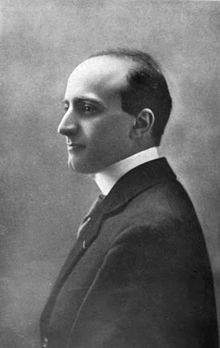|
Michel-Dimitri Calvocoressi
 Michel-Dimitri Calvocoressi (2 October 1877 – 1 February 1944) was a French-born music critic and musicologist of Greek descent who was a British citizen and resident in England from 1914 onwards.[1] He is especially noted for his writings on Russian classical music, particularly on the life and works of Modest Mussorgsky, and his close association with the French musical establishment. Born in Marseille, Calvocoressi learned numerous languages in his youth and attempted various careers before settling on music criticism. His early career was spent as an influential music critic in Paris, where he contributed to English and French newspapers: Gil Blas, the Comoedia Illustré, The Morning Post and The Musical Times, among others. He was well acquainted with the city's musical figures, particularly Maurice Ravel. Alongside Ravel and the pianist Ricardo Viñes, Calvocoressi founded the Apaches musical society. After serving as a cryptographer in England for World War I, he remained in London to continue criticism and musicological writing for the rest of his life. Although he wrote his later books in English and came to know English cultural figures such as Arnold Bennett and Ralph Vaughan Williams, his colleague Gerald Abraham remarked that "he never enjoyed the influence and authority in London that he had exercised in Paris".[2] In addition to his writings on Russian music and Mussorgsky, he wrote on the music of Liszt, Glinka, Schumann, Koechlin and Debussy. Early life and educationMichel-Dimitri Calvocoressi was born in Marseille, France on 2 October 1877 to Greek parents.[3] In his earliest years he learned French, Greek, Italian, English and later German; he noted that "I read far more English books than French."[4] At the École Monge high school of Paris, he developed a lifelong interest in geology and mineralogy.[4] The musicologist Gerald Abraham notes that Calvocoressi had "a number of false starts at other careers: law, banking and stockbroking".[4] At first, he studied at the Lycée Janson de Sailly, Paris, but inspiration from an Orchestre Lamoureux concert of Richard Wagner's works galvanized his interest in music.[4][a] Alongside his piano lessons with Eugène Claveau, Calvocoressi frequented the Parisian concert scene, with works by Bach, Liszt, d'Indy, Wagner, and the Romantic Russian composers in particular leaving a lasting impression.[4] He began harmony study at the Conservatoire de Paris with Xavier Leroux, where he became friends with the composer Maurice Ravel;[2] Ravel later dedicated "Alborada del gracioso" from the piano suite Miroirs to Calvocoressi.[5][b] Ravel also harmonized a set of Greek folk songs which Calvocoressi translated, known as Cinq mélodies populaires grecques, and may have inspired the composer's piano Sonatine.[7] Calvocoressi, Ravel and the pianist Ricardo Viñes founded the Apaches music society..[8] Other members were the composers Florent Schmitt, Maurice Delage and Paul Ladmirault, the poets Léon-Paul Fargue and Tristan Klingsor and the painter Paul Sordes.[9][10][11] Career and later life Calvocoressi's music criticism career can be divided into two: a French (1902–1914) and English (1921–1944) period.[12] Described by Abraham as "a remarkable polyglot", Calvocoressi's career beginning in 1902 was as a music critic and correspondent for several English, American, German and Russian periodicals.[2] Encouraged by the novelist Binet-Valmer, the latter introduced him to Octave Maus, an editor of the monthly L'Art Moderne magazine.[4] Calvocoressi became the Paris musical correspondent for L'Art Moderne and music critic for Binet-Valmer's La Renaissance latine magazine; around then he also was music critic for the Anglo-French Weekly Critical Review.[4] Although some of these publications became obsolete in the next few years, Calvocoressi was well established enough to be unaffected.[13] He contributed to other publications and various time: the daily Gil Blas, the fortnightly Comoedia Illustré'' (part of Comœdia), the daily The Morning Post and particularly monthly Musical Times.[12] Calvocoressi published his first book—a study on Franz Liszt—in 1905, the year when he began writing for the English Monthly Musical Record, began both a correspondence with the Russian composer Mily Balakirev and developed a general interest in Russian music, particularly the work of Modest Mussorgsky.[12] From 1907 to 1910 he served as an advisor for the impresario Sergei Diaghilev, who organized Russian music and ballet concerts in Paris.[2] For his efforts, the Russian government granted him the Order of Saint Anna, while the Soviets later elected him a member of the Academy of Sciences of the Soviet Union.[12] He visited Russia for the first and only time in 1914, meeting with musical figures such as Alexander Glazunov.[12] Calvocoressi lectured at the École des Hautes Études Sociales from 1905 to 1914, teaching about contemporary music.[2] He also translated song texts, opera librettos and books from Russian and Hungarian into French and English.[2] His next books included studies on Mussorgsky (1908), Glinka (1911) and Schumann (1912).[2] Calvocoressi paused music criticism at the onset of World War I in 1914, but found himself unable to serve the French due to his Greek ancestry.[2] Later that year he moved to London and served as a cryptographer.[2] He spent the rest of his life in England; he was naturalized and married Ethel Grey, a British citizen who was the dedicatee of many of his future books.[12] These later studies were all in English, and their subjects included Koechlin (1923), music criticism (1923), musical taste (1925), recollections of his musical experiences (1933), Debussy (1944) as well on two studies each on Russian music (1936 & 1944) and Mussorgsky specifically (1946 & 1956).[2] Although he continued music criticism in London from 1921 onwards, Abraham remarked that "he never enjoyed the influence and authority in London that he had exercised in Paris".[2] Calvocoressi became well acquainted with "many distinguished Englishmen", including the author Arnold Bennett and the composer Ralph Vaughan Williams.[2] He died in London on 1 February 1944.[4] Selected writingsBooks
Articles
ReferencesNotes
Citations
Sources
Further reading
External links
|